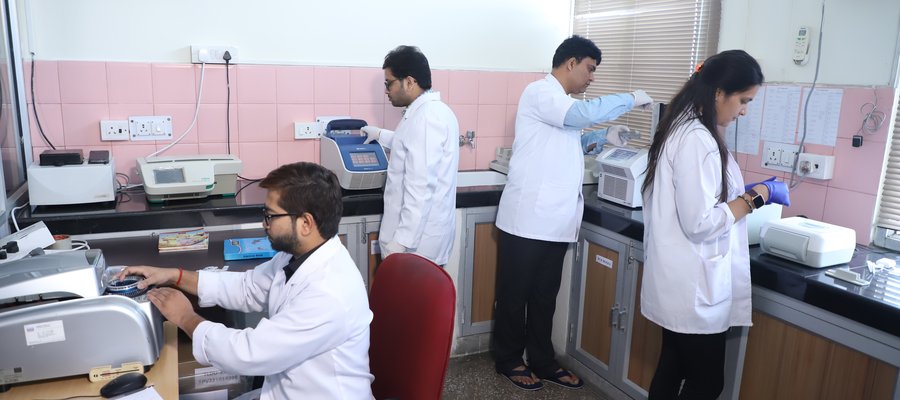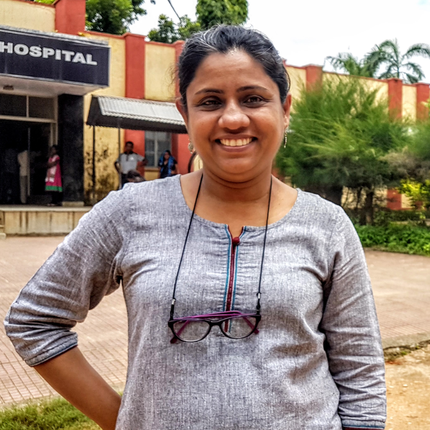Research in India

Research - a cross-cutting issue
At TLMTI, research is a cross-cutting issue, carried out in its molecular biology research laboratory (Stanley Browne Research Laboratory, Delhi) and in its 14 hospitals, six vocational training centres and many community empowerment projects.
Our current priority areas of research are: transmission, early diagnosis, biomarkers for early detection, reactions and nerve function impairment, disability management, emerging patterns of drug resistance, stigma measurement and interventions to reduce it, inclusion and integration, and advocacy research

Leprosy is likely transmitted by droplets from the nose and mouth during prolonged and close contact with untreated leprosy patients - however, are there other reservoirs of M. leprae such as water sources, soil etc. TLM Trust India's Stanley Browne Laboratory has published a number of papers demonstrating the presence of M. leprae in the environment. Two recent papers are listed below:
V. Singh, RP Turankar, A Goel (2020) Real-time PCR-based quantitation of viable Mycobacterium leprae strain from clinical samples and environmental sources and its genotype in multicase leprosy families of India. Eur J Clin Microbiol Infect Dis. 10.1007/s10096-020-03958-w. doi:10.1007/s10096-020- 03958-w
Our findings showed the presence of similar strain of M. leprae in leprosy cases, their household contacts and surrounding environment, suggesting source of infection could be from environment or from cases or from both sources.
Ravindra P. Turankara, Mallika Lavania, Joydeepa Darlong, K.S.R.Siva Saib U.Sengupta, Rupendra S.Jadhav (2019) Survival of Mycobacterium leprae and association with Acanthamoeba from environmental samples in the inhabitant areas of active leprosy cases: A cross sectional study from endemic pockets of Purulia, West Bengal https://doi.org/10.1016/j.meegid.2019.01.014
This suggests that the surrounding environment (soil and water) of leprosy patients contain viable M. leprae and could play an important role in the focal transmission of the disease.
Early diagnosis of leprosy is important for limiting the severity of disease, which may lead to disabilities and deformities if not treated timely. Multiplex PCR employing more than one gene, specific to target DNA, is more efficient detection tool. In this study, slit skin scrapings, blood, nasal swabs and saliva from Paucibacillary (PB) and Multibacillary (MB) cases as well as household contacts of PB cases were tested by multiplex PCR using three different gene targets namely RLEP, 16SrRNA and sodA. We found an increase in overall diagnostic positivity for M. leprae DNA detection by M-PCR as compared to individual PCR. In case of nasal swabs using M-PCR the PPV, NPV were 0.5454, 0.8333 respectively. There is remarkable increase in PPV in SSS of PB cases and nasal swabs of HHCs using M-PCR. Conclusively, our finding suggests the utility of M-PCR for early diagnosis and household contact surveillance for leprosy.
Vinay Kumar Pathak, Itu Singh, Ravindra P Turankar, Mallika Lavania, Madhvi Ahuja, Vikram Singh, Utpal Sengupta Utility of multiplex PCR for early diagnosis and household contact surveillance for leprosy. Diagnostic Microbiology and Infectious Disease Volume 95, Issue 3, November 2019, 114855 https://doi.org/10.1016/j.diagmicrobio.2019.06.007
Characteristics of children with leprosy: Factors associated with delay in disease diagnosis
The objectives of the study were to characterise the clinical profile of childhood leprosy presenting at tertiary leprosy care hospitals in the states of Bihar, West Bengal and Uttar Pradesh in India, and to determine the possible risk factors associated with disabilities at presentation. The research concluded that childhood leprosy continues to occur in endemic pockets in India and a substantial number present with skin smear positivity and deformity. Guardians of these children cite many reasons for the delay in presentation.
Darlong J, Govindasamy K, Daniel A. Characteristics of children with leprosy: Factors associated with delay in disease diagnosis. Indian J Dermatol Venereol Leprol 2022;88:337-41. doi: 10.25259/IJDVL_1382_20
Vengalil S, Lavania M, Singh I, Nashi S et al. (2020) Appropriately Selected Nerve in Suspected Leprous Neuropathy Yields High Positive Results for Mycobacterium leprae DNA by Polymerase Chain Reaction Method. The American journal of tropical medicine and hygiene /doi.org/10.4269/ajtmh.19-0746
Clinical, histopathological, and PCR tests complement each other to help achieve a definitive diagnosis of leprosy particularly in pure neuritic leprosy and in leprous neuropathy with negative skin smears/biopsy
TLM Trust India is a member of the WHO surveillance network of antimicrobial resistance (AMR) in leprosy. We also collaborate with researchers from Indian and international universities, laboratories, the Indian Council of Medical Research, and the Department of Science and Technology, India.
TLM Trust India regularly publishes its findings on AMR in leprosy and was first to publish information about rifampicin resistant patient cases.
Mallika Lavania, Itu Singh, Ravindra P Turankar, Madhvi Ahuja , Vinay Pathak, Utpal Sengupta, Loretta Das, Archana Kumar, Joydeepa Darlong, Rajeev Nathan, Asha Maseey (2018) Molecular detection of multidrug-resistant Mycobacterium leprae from Indian leprosy patients J Glob Antimicrob Resist. 2018 Mar;12:214-219. doi: 10.1016/j.jgar.2017.10.010.
Kamat, T Narang, M Ahuja, M Lavania, S Dogra (2020) Case Report: Multidrug-Resistant Mycobacterium leprae in a Case of Smear-Negative Relapse. American Journal of Tropical Medicine and Hygiene, 102:724 – 727. DOI: 10.4269/ajtmh.19-0905
Detection of multidrug resistance in a case with negative SSS and innocuous histopathology is rather unusual and highlights the importance of undertaking drug resistance tests even in smear-negative cases of leprosy relapse.
Sardana K, Kulhari A, Mathachan SR, Khurana A, Bansal P, Ahuja A, Lavania M, Ahuja M (2020) Late Leprosy Reaction Presenting as Erythema Multiforme-Like Erythema Nodosum Leprosum with Underlying Rifampicin Resistance and its Potential Implications. Int J Mycobacteriol. 9:226-8. DOI: 10.4103/ijmy.ijmy_26_20
Burden of depression and anxiety among leprosy affected and associated factors—A cross sectional study from India
The study indicates that more than 30% of people affected by leprosy have mental health problems, which emphasizes the importance of mental health care services in leprosy. Women, those who had lower level of education, those belonging to lower socio-economic status and those with any level of disability due to leprosy are at risk of developing depression and/or anxiety. The study concludes more attention to be paid to the categories identified to be at risk.
Govindasamy K, Jacob I, Solomon RM, Darlong J (2021) Burden of depression and anxiety among leprosy affected and associated factors—A cross sectional study from India. PLoS Negl Trop Dis 15(1): e0009030. https://doi.org/10.1371/journal.pntd.0009030
Leprosy is caused by a bacterium and is curable with a combination of antibiotics known as multi-drug therapy, which patients take for six or 12 months. However, a significant proportion of leprosy patients experience severe inflammation in their skin, nerves and other organs known as erythema nodosum leprosum (ENL). ENL is a severe complication of leprosy which can occur before, during, or after completion of antibacterial treatment. ENL causes severe morbidity affecting not only the skin, but also bones, joints, eyes, nerves, testes and kidneys. ENL may be fatal and it has been shown that the adverse effects of corticosteroid treatment also contribute to mortality.
ENLIST group (Erythema Nodosum Leprosum International STudy Group)
TLM Trust India and TLM Nepal are both members of the ENLIST group.
The ENLIST group is increasing our understanding of the risk factors for ENL, how to measure it severity and improving how we treat ENL and support those who suffer with it. Read more about ENLIST here.
ENL causes chronic or recurrent episodes of ill-health over many years. We have also demonstrated that having a family member affected by ENL places considerable financial burden on households
David J. Chandler, Kristian S. Hansen, Bhabananda Mahato, Joydeepa Darlong, Annamma John, Diana N. J. Lockwood (2015) Household Costs of Leprosy Reactions (ENL) in Rural India PLOS NTDs https://doi.org/10.1371/journal.pntd.0003431
Household costs resulted predominantly from the impact of ENL on the productivity (ability to earn money) of household members. Out of pocket expenditure on treatment-seeking in the private sector accounted for the remaining costs. Leprosy affects poor and marginalised communities in low- and middle-income countries across the world; households affected by ENL are at risk of being pushed further into poverty.
TLM Trust India is using computer-aided design (CAD) and computer aided-manufacturing (CAM) software to design and produce footwear and orthoses for people affected by leprosy with insensate feet and at risk of plantar ulcers. A recent paper shows that CAD/CAM technology is more effective in preventing recurrent ulcers of the foot due to leprosy as compared to footwear using micro-cellular rubber (MCR), with increased compliance and patient perceived comfort, usefulness, participation, and activity level.
Karthikeyan Govindasamy, N. R. Raja, Pankaj Gupta, Gaurav Anand, Premal Das, Famkima Darlong, Joydeepa Darlong; Computer assisted customized footwear and traditional micro-cellular rubber (MCR) footwear to reduce recurrence of ulcer for patients with loss of sensation due to leprosy; Leprosy Review; 2020; 91; 4; 383-392; DOI: 10.47276/lr.91.4.383
In collaboration with partners in Nepal, Nigeria and the UK, TLM Trust India is studying how to improve the management of leprosy ulcers - specifically looking at the sustainability of self-help groups in Chattisghar, but also contributing to a comprehensive guidelines on self-care for leprosy and other NTDs.
MS Raju, Rao PSS, and Karthikeyan G: Socio-medical perspectives on leprosy in Indian religions. Lepr Rev (2020) 91, 190–199
The study found a historical basis for leprosy stigma in the scriptures of all six religions. Attitudes are changing, especially with the acceptance of modern treatment. It is essential to incorporate stigma reduction perspectives in religious preaching.
Joydeepa Darlong, Pitchaimani Govindharaj; Parents’ attitude towards their children and adolescents affected by leprosy in an endemic district in West Bengal, India; Leprosy Review; 2020; 91; 3; 282-290; DOI: 10.47276/lr.91.3.282
This is the first study to investigate the parents’ attitude towards their children affected by leprosy. The study showed that the parents had a positive attitude towards their child’s disease.


